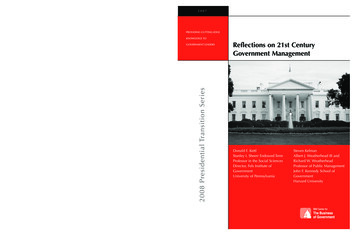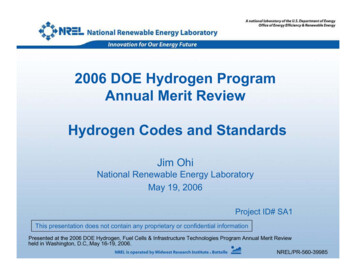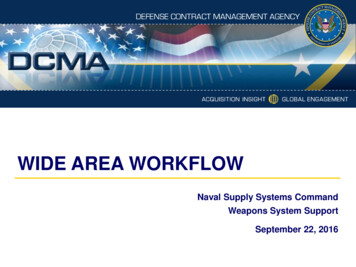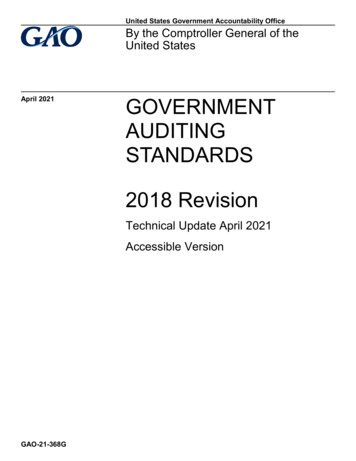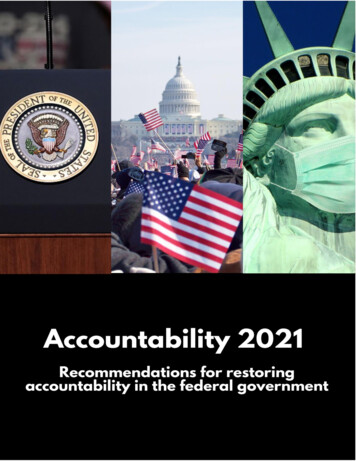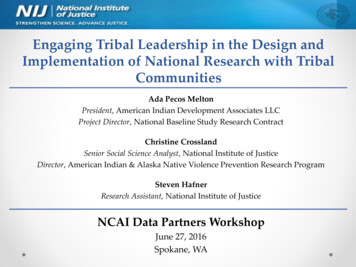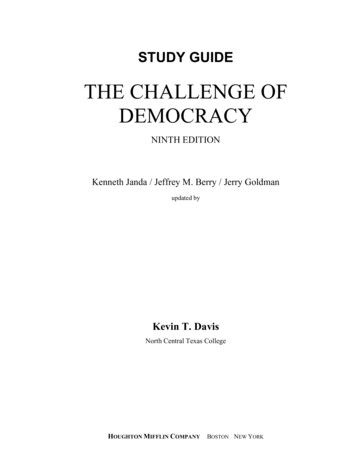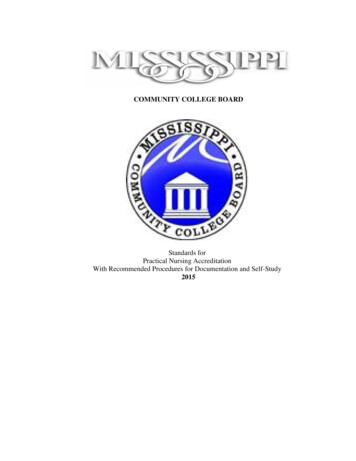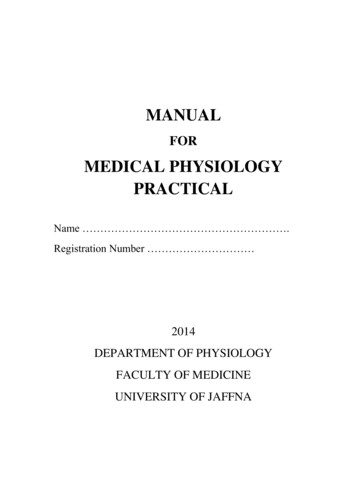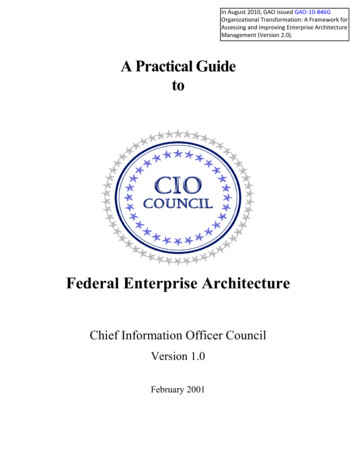
Transcription
In August 2010, GAO issued GAO-10-846GOrganizational Transformation: A Framework forAssessing and Improving Enterprise ArchitectureManagement (Version 2.0).A Practical GuidetoFederal Enterprise ArchitectureChief Information Officer CouncilVersion 1.0February 2001
PrefaceAn enterprise architecture (EA) establishes the Agency-wide roadmap to achieve an Agency’s missionthrough optimal performance of its core business processes within an efficient information technology(IT) environment. Simply stated, enterprise architectures are “blueprints” for systematically andcompletely defining an organization’s current (baseline) or desired (target) environment. Enterprisearchitectures are essential for evolving information systems and developing new systems that optimizetheir mission value. This is accomplished in logical or business terms (e.g., mission, business functions,information flows, and systems environments) and technical terms (e.g., software, hardware,communications), and includes a Sequencing Plan for transitioning from the baseline environment to thetarget environment.If defined, maintained, and implemented effectively, these institutional blueprints assist in optimizing theinterdependencies and interrelationships among an organization’s business operations and the underlyingIT that support operations. The experience of the Office of Management and Budget (OMB) and GeneralAccounting Office (GAO) has shown that without a complete and enforced EA, federal agencies run therisk of buying and building systems that are duplicative, incompatible, and unnecessarily costly tomaintain and integrate.For EAs to be useful and provide business value, their development, maintenance, and implementationshould be managed effectively. This step-by-step process guide is intended to assist agencies in defining,maintaining, and implementing EAs by providing a disciplined and rigorous approach to EA life cyclemanagement. It describes major EA program management areas, beginning with suggestedorganizational structure and management controls, a process for development of a baseline and targetarchitecture, and development of a sequencing plan. The guide also describes EA maintenance andimplementation, as well as oversight and control. Collectively, these areas provide a recommendedmodel for effective EA management.BackgroundReflecting the general consensus in industry that large, complex systems development and acquisitionefforts should be guided by explicit EAs, Congress required Federal Agency Chief Information Officersto develop, maintain, and facilitate integrated systems architectures with the passage of the Clinger-CohenAct1in 1996. Additionally, OMB has issued guidance that requires agency information systemsinvestments to be consistent with Federal, Agency, and bureau architectures. Other OMB guidanceprovides for the content of Agency enterprise architectures.2 Similarly, the Chief Information OfficerCouncil, the Department of the Treasury, the National Institute of Standards Technology (NIST), andGAO, have developed architecture frameworks or models that define the content of enterprisearchitectures.31Public Law 104-106, section 5125, 110 Stat. 684 (1996).OMB Circular A-130, Management of Federal Information Resources, November 30, 2000.3Federal Enterprise Architecture Framework, Version 1.1, Federal Chief Information Officers Council, September1999; Treasury Enterprise Architecture Framework, Version 1, the Department of the Treasury, July 3, 2000; theNational Institute of Standards and Technology’s Enterprise Architectural Model, referenced in NIST SpecialPublication 500-167, Information Management Directions: the Integration Challenge; and Strategic InformationPlanning: Framework for Designing and Developing System Architectures (GAO/IMTEC-92-51, June 1992).2iiiFebruary 2001
A Practical Guide to Federal Enterprise ArchitecturePrefaceThis guide builds upon, complements, and is directly linked to the GAO Information TechnologyInvestment Management (ITIM) framework4 that was developed to provide a common structure fordiscussing and assessing IT capital planning and investment control (CPIC) practices at Federal Agencies.ITIM enhances earlier Federal IT investment management guidance by extending theSelect/Control/Evaluate approach, mandated by the Clinger-Cohen Act, into a growth and maturityframework.5 It is also directly linked to the Federal Enterprise Architecture Framework.The Need for this GuideWhile these frameworks and models provide valuable guidance on the content of enterprise architectures,there is literally no federal guidance how to successfully manage the process of creating, changing, andusing the enterprise architecture. This guidance is crucially important. Without it, it is highly unlikelythat an organization can successfully produce a complete and enforceable EA for optimizing its systems’business value and mission performance. For example, effective development of a complete EA needs acorporate commitment with senior management sponsorship. The enterprise architecture developmentshould be managed as a formal project by an organizational entity that is held accountable for success.Since the EA facilitates change based upon the changing business environment of the organization, thearchitect is the organization’s primary change agent. Effective implementation requires establishment ofsystem compliance with the architecture, as well as continuous assessment and enforcement ofcompliance. Waiver of these requirements may occur only after careful, thorough, and documentedanalysis. Without these commitments, responsibilities, and tools, the risk is great that new systems willnot meet business needs, will be incompatible, will perform poorly, and will cost more to develop,integrate, and maintain than is warranted.ConclusionThe processes described in this guide represent fundamental principles of good EA management. Sincethe guide is not a one-size-fits-all proposition, Agencies or organizations should adapt itsrecommendations and steps to fit their individual needs. We encourage you to consider these EAprocesses and best practices carefully before pursuing other approaches.An electronic version of this guide is available at the following Internet address: http://www.cio.gov.If you have questions or comments about this guide, please contact Rob C. Thomas II at (703) 921-6425,by email at rob.c.thomas@customs.treas.gov, or by mail at:U.S. Customs Service7681 Boston BoulevardSpringfield, VA 221534Information Technology Investment Management: A Framework for Assessing and Improving Process Maturity(GAO/AIMD-10.1.23, Exposure Draft, 2000).5In the Select Phase, the costs and benefits of all available projects are assessed and the optimal portfolio of projectsis selected. During the Control Phase, the portfolio is monitored and corrective action is applied where needed. Inthe Evaluate Phase, implemented projects are reviewed to ensure that they are producing the benefits expected andadjustments are made where appropriate.ivFebruary 2001
A Practical Guide to Federal Enterprise ArchitecturePrefaceCreditsThis document was produced by the Federal Architecture Working Group (FAWG) under the strategicdirection of the Enterprise Interoperability and Emerging Information Technology Committee (EIEITC)of the Federal Chief Information Officer Council.The following persons contributed to accomplishing this Guide.NameRob C. Thomas, IIRandolph C. HiteRay BeamerWilliam H. McVayElaine WardKeith RhodesMary Lou CollinsGeorge BrundageScott BernardLester DiamondMichael A. TiemannThomas P. CullenWilliam LewJohn AndersonDaryl KnuthBarbara ScottPaul J. ParadisNaba BarkakatiKathy SowellWayne ShiveleyTitleDir., Tech. & Arch. Group, Chief ArchitectDir., Information Technology Systems IssuesSenior Principal ScientistSenior Policy AnalystPrincipal EngineerChief TechnologistLead EngineerChief ArchitectManagement ConsultantAssistant DirectorDir., Arch. & Stnds. Div., Chief ArchitectPolicy AnalystTechnical Assistant DirectorPrincipal EngineerInformation ArchitectManagement AnalystManagement AnalystTechnical Assistant DirectorLead EngineerSenior Computer ScientistAgencyU.S. Customs ServiceGeneral Accounting OfficeThe MITRE CorporationOffice of Management and BudgetThe MITRE CorporationGeneral Accounting OfficeThe MITRE CorporationU.S. Department of the TreasuryBooz-Allen & Hamilton, Inc.General Accounting OfficeU.S. Department of EnergyU.S. Customs ServiceGeneral Accounting OfficeThe MITRE CorporationU.S. Customs ServiceU.S. Department of EducationU.S. Department of EnergyGeneral Accounting OfficeThe MITRE CorporationFederal Bureau of InvestigationvFebruary 2001
A Practical Guide to Federal Enterprise ArchitecturePrefaceviFebruary 2001
Table of ContentsPrefaceiii1.Introduction. 11.1. Purpose. 11.2. Scope. 11.3. Audience . 11.4. Document Organization . 21.5. How to Use this Guide . 31.6. Related Documents . 42.Definitions, Drivers, and Principles . 52.1. Enterprise Architecture Defined . 52.2. The Uses and Benefits of Enterprise Architecture. 52.3. Legislation and other Guidance . 62.4. Architecture Principles. 72.5. The Enterprise Life Cycle. 82.6. The Enterprise Architecture Process. 93.Initiate Enterprise Architecture Program. 113.1. Obtain Executive Buy-in and Support . 113.1.1. Ensure Agency Head Buy-in and Support . 113.1.2. Issue an Executive Enterprise Architecture Policy . 113.1.3. Obtain Support from Senior Executives and Business Units. 123.2. Establish Management Structure and Control. 133.2.1. Establish a Technical Review Committee . 143.2.2. Establish a Capital Investment Council . 143.2.3. Establish an EA Executive Steering Committee. 143.2.4. Appoint Chief Architect. 143.2.5. Establish an Enterprise Architecture Program Management Office . 153.3. Enterprise Architecture Program Activities and Products . 173.3.1. Develop an EA Marketing Strategy and Communications Plan. 173.3.2. Develop an EA Program Management Plan . 183.3.3. Initiate Development of the Enterprise Architecture . 184.Define an Architecture Process and Approach . 214.1. Define the Intended Use of the Architecture. 224.2. Define the Scope of the Architecture. 224.3. Determine the Depth of the Architecture . 224.4. Select Appropriate EA Products . 234.4.1. Select Products that Represent the Business of the Enterprise . 234.4.2. Select Products that Represent Agency Technical Assets . 244.5. Evaluate and Select a Framework. 244.5.1. Federal Enterprise Architecture Framework. 25viiFebruary 2001
A Practical Guide to Federal Enterprise ArchitectureContents4.5.2. DoD C4ISR Architecture Framework. 274.5.3. Treasury Enterprise Architecture Framework. 284.6. Select an EA Toolset. 305.Develop the Enterprise Architecture . 335.1. Collect Information. 345.2. Generate Products and Populate EA Repository. 355.2.1. Essentials in Building the Baseline Architecture . 365.2.2. Essentials in Building the Target Architecture . 365.2.3. Review, Validate, and Refine Models . 385.3. Develop the Sequencing Plan . 385.3.1. Identify Gaps. 395.3.2. Define and Differentiate Legacy, Migration, and New Systems . 395.3.3. Planning the Migration . 405.4. Approve, Publish, and Disseminate the EA Products . 416.Use the Enterprise Architecture . 436.1. Integrate the EA with CPIC and SLC Processes. 436.1.1. Train Personnel . 456.1.2. Establish Enforcement Processes and Procedures . 456.2. Execute the Integrated Process . 476.2.1. Initiate New and Follow-on Projects . 476.2.2. Execute the Projects. 516.2.3. Complete the Project. 526.3. Other Uses of the EA . 547.Maintain the Enterprise Architecture . 55Maintain the Enterprise Architecture as the Enterprise Evolves . 557.1.1. Reassess the Enterprise Architecture Periodically. 557.1.2. Manage Products to Reflect Reality. 567.2. Continue to Consider Proposals for EA Modifications. 578.Continuously Control and Oversee the Enterprise Architecture Program. 598.1. Ensure Necessary EA Program Management Controls Are In Place and Functioning. 598.2. Identify Where EA Program Expectations Are Not Being Met. 598.3. Take Appropriate Actions to Address Deviations . 608.4. Ensure Continuous Improvement. 609.Summary . 63Appendix A: EA Roles and Responsibilities. 65Appendix B: Glossary. 67Appendix C: Acronyms . 71Appendix D: Example Architecture Products. 73D.1. Mission and Vision Statements. 73viiiFebruary 2001
A Practical Guide to Federal Enterprise ArchitectureContentsD.2. Information Dictionary . 73D.3. Concept of Operations (CONOPS) Graphic . 74D.4. Activity Models and Trees. 76D.5. Business Use Case Model . 78D.6. Class Model . 81D.7. State Model . 82D.8. Node Connectivity Diagrams. 83D.9. Information Exchange Matrix. 86D.10. Organization Chart. 87D.11. Systems Interface Description and Connectivity Diagram . 88D.12. Standards Profile. 89D.13. Technical Reference Model . 90Appendix E: Sample Architectural Principles . 93Appendix F: Bibliography. 97Appendix G: The Zachman Framework . 101ixFebruary 2001
List of FiguresFigure 1. Role of Architecture Principles . 7Figure 2. The Enterprise Life Cycle. 8Figure 3. The Enterprise Architecture Process . 9Figure 4. Notional EA Organization . 13Figure 5. Depth and Detail of the Architecture. 21Figure 6. Structure of the FEAF Components . 26Figure 7. FEAF Architecture Matrix. 26Figure 8. DoD C4ISR Framework . 27Figure 9. DoD C4ISR Products . 28Figure 10. The Treasury Enterprise Architecture Framework . 29Figure 11. TEAF Products . 30Figure 12. Example Approach for EA Development. 33Figure 13. Systems Migration Chart . 40Figure 14. IMP/Architecture Project Assessment Framework . 44Figure 15. Architecture Management . 45Figure 16. Define New and Follow-on Programs/Projects . 48Figure 17. Execute Programs/Projects . 51Figure 18. Evaluate Programs/Projects. 53Figure 19. Enterprise Architecture Transition . 56Figure 20. Key Success Factors . 61Figure 21. DoD Battlespace Concept of Operations Graphic . 74Figure 22. U.S. Customs Service Trade Compliance Concept of Operations Graphic. 75Figure 23. Generic IDEF Activity Model . 77Figure 24. U.S. Customs, ACS, Activity Tree. 77Figure 25. U.S. Customs, Trade Compliance, UML Activity Model . 78Figure 26. U.S. Customs, Trade Compliance—External, UML Use Case Diagram . 79Figure 27. U.S. Customs, Trade Compliance—Internal, UML Use Case Diagram . 79Figure 28. U.S. Customs, Trade Compliance, Declare Goods, UML Use Case Specification. 80Figure 29. U.S. Customs, Trade Compliance, Commercial View, UML Class Diagram. 81Figure 30. U.S. Customs, Trade Compliance, Carrier, UML State Diagram . 82Figure 31. U.S. Customs, ACS, Customs Systems, Node Connectivity Diagram. 84Figure 32. U.S. Customs, ACS, N2 Chart. 85Figure 33. U.S. Air Force Node Connectivity Diagram . 86Figure 34. Generic Organization Chart. 88Figure 35. Generic System Interface Description Connectivity Diagram . 89Figure 36. Standards Profile Table . 90Figure 37. U.S. Customs Technical Reference Model. 90Figure 38. Generic TRM Domain and Sub-domain Definitions and Components. 91Figure 39. The Zachman Framework Matrix. 102xFebruary 2001
List of TablesTable 1. EAPMO Roles and Responsibilities . 17Table 2. Framework Selection Criteria . 25Table 3. Tool Selection Criteria. 31Table 4. Baseline and Target Architecture Differentiators . 35Table 5. EA Review Goals. 50Table 6. Example Logical Information Exchange Matrix . 87xiFebruary 2001
1.Introduction1.1.PurposeThe purpose of this document is to provide guidance to Federal Agencies in initiating,developing, using, and maintaining an enterprise architecture (EA). This guide offers an end-toend process to initiate, implement, and sustain an EA program, and describes the necessary rolesand associated responsibilities for a successful EA program.An EA establishes the Agency-wide roadmap to achieve an Agency’s mission through optimalperformance of its core business processes within an efficient information technology (IT)environment. Simply stated, enterprise architectures are “blueprints” for systematically andcompletely defining an organization’s current (baseline) or desired (target) environment.Enterprise architectures are essential for evolving information systems, developing new systems,and inserting emerging technologies that optimize their mission value. While some agencies haveenterprise architectures in place, others do not. For agencies that already have an EA in place,this guide should be tailored to fit these Agencies’ needs. For smaller agencies, a streamlinedversion of the guide should be created to support the needs of the Agency.1.2.ScopeThis guide focuses on EA processes, products, and roles and responsibilities. While this guideaddresses the enterprise life cycle, it describes in detail how the EA processes relate to enterpriseengineering, program management, and capital planning and investment control (CPIC)processes.The breadth and depth of information presented here should be tailored to your organization.Some examples are presented in the appendices, and references to supplementary material areincluded in the text or bibliography. Feel free to individualize these examples as needed.1.3.AudienceThis guide is intended primarily for Federal Agency architects tasked with the generation andinstitutionalization of EAs. This document provides guidance to Agencies that currently do nothave EAs and those that can benefit from improvements in their EA methods for developmentand maintenance. For Agencies without an EA, this document provides useful guidance to theAgency Head and the Chief Information Officer (CIO) for educating and obtaining keystakeholder commitment in establishing an effective EA.This guide is also aimed at CPIC process participants [e.g., investment review boards, and theOffice of Management and Budget (OMB)], as well as enterprise engineering and programmanagement process participants (e.g., program/project managers, systems engineers, applicationarchitects, systems developers, configuration managers, risk managers, and security engineers).Although the guide specifically addresses the roles and responsibilities of major players in thearchitecture development process, it is also a handbook for anyone who needs to know moreabout the EA process. Regardless of your role or responsibility—whether you have soleresponsibility for EA development or are a member of an architecture team—if you are involvedin the enterprise life cycle, this guide is for you.1February 2001
A Practical Gui
A Practical Guide to Federal Enterprise Architecture Chief Information Officer Council Version 1.0 February 2001. In August 2010, GAO issued GAO-10-846G Organizational Transformation: A Framework for Assessing and Improving Enterprise Architecture Management \(Version 2.0\).
